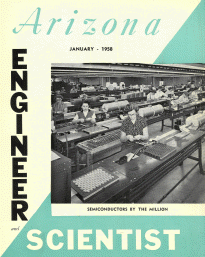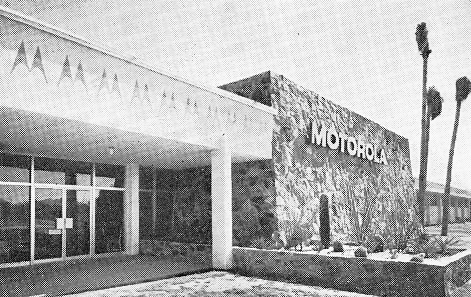|
MOTOROLA SEMICONDUCTOR DIVISION
|
|
Few Arizonans know that Motorola's Semiconductor Division is the world's largest producer of germanium power transistors and is rapidly becoming a major factor in the semiconductor industry. Motorola chose the Phoenix area for this new division after an extensive survey disclosed that the "Valley of the Sun" was very nearly an ideal location for the manufacture of semiconductor products. The apparent disadvantage of locating at some distance from the major electronic component marketing areas is overcome by the high value to weight ratio of semiconductor products which reduces the cost of transportation to market to a minor factor. Particular attention to developing effective means of communications with the industry removed the most serious objection to a location remote from the market. The factors favoring semiconductor product manufacture in Phoenix are many and include the clean, low-humidity atmosphere, excellent rail, air, and highway transportation, ready availability of skilled employees, and the well known drawing power of excellent living conditions for present and prospective technical employees. Motorola has long been recognized as a leader in the auto and home radio, television, commercial communication equipment, and military electronics industries. Since such industries are very large users of electronic components, it was logical and desirable that Motorola support these activities with the new and revolutionary components now appearing on the electronics scene. The primary objective of the Semiconductor Division is to become a major supplier of semiconductor components to the international industrial, military, and commercial electronics industry. A parallel objective is to support the internal company requirements for semiconductor components of high quality, in quantity. To meet these ambitious objectives, the Motorola Semiconductor Division management, led by Mr. John T. Hickey, General Manager, has developed an experienced, highly-qualified organization of well over five hundred people including a large percentage of semiconductor scientists and engineers. The facilities to support this growing organization are located at 5005 East McDowell Road in Phoenix and presently cover 68,000 square feet of area with 35 acres available for future expansion. This facility was the first to be designed and built specifically for the complex processes involved in mass manufacturing of semiconductor products. Super-pure argon, hydrogen, and nitrogen gases are piped throughout the production and experimental areas, as is de-ionized water and natural gas. A honeycomb of acid proof drain piping allows immediate dispersal of active reagents and noxious gases to an outside underground neutralizing chamber. The production lines are arranged for optimum efficiency of material flow, are well lighted and equipped with the latest production and test equipment. For the comfort and efficiency of the personnel, the production and cafeteria areas are wired for hi-fi music, and the entire plant is air-conditioned.Products manufactured by the Motorola Semiconductor Division have received excellent acceptance by the electronic industries both on this continent and abroad. The ability of Motorola Semiconductors to produce germanium power transistors in quantity at an early date made possible the hybrid auto radio which is a Motorola first. It is estimated that in 1958 more than 90% of the five to six million auto radios built will be equipped with one or more germanium power transistors. The present Motorola production rate of these transistors is well over two million per year with increased requirements indicated for 1958. Other present products of the Semiconductor Division are high-voltage industrial type germanium power transistors, a new military type high-speed germanium computer transistor, and a line of silicon power rectifiers. All of these products are adaptable to mass production techniques involving a high degree of process and parameter control. The development of new products is proceeding rapidly with intense concentration directed toward raising the present limits on frequency of operation, power, and device gain, and at the same time lowering the cost of manufacture. By stressing the development of new semi-conductor devices which are adaptable to mass manufacture, Motorola Incorporated is assured of an increasingly important position in the semiconductor industry. Page 1 - January - 1958 ©ARIZONA ENGINEER AND SCIENTIST - From the Hammond Collection at SMECC
|


